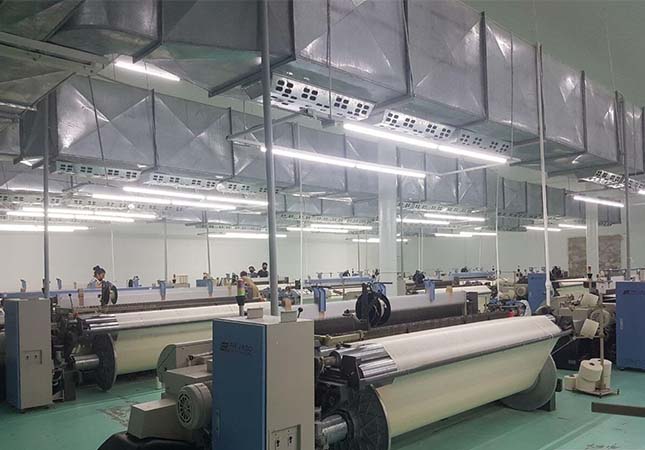The Fourth International Textile Expo was held in the southern Pakistani city of Karachi few days ago, attracting global attention once again to this important South Asian country.
As we all know, the textile industry and textile machinery has always been the backbone of Pakistan's economy. Since the 1990s, the Pakistani textile industry has experienced rapid development over several decades, making Pakistan one of the significant producers and exporters of textiles in the international market. The textile industry accounts for nearly 40% of the country's employment and contributes to nearly half of the manufacturing output. It can be said that the textile industry and textile machinery has become the foundation of Pakistan's position in the regional and global context.

In the early 1990s, Pakistan's private sector entered a period of rapid development, and the textile industry, primarily focused on cotton spinning, experienced a "golden age." In May 1990, the Pakistani government issued a policy granting "8-year tax exemptions for industrial enterprises established in underdeveloped areas." In the same year, in November, the new government introduced more stimulating economic policies, including the elimination of direct government intervention in the economy, complete relaxation of foreign exchange controls, and the privatization of state-owned enterprises and utilities.
As a result, a "cotton spinning fever" swept across Pakistan, with a large number of domestic investors entering the industry. They purchased land at relatively low prices, imported high-quality textile equipment from abroad, rapidly established factories, and continuously exported finished products to multiple countries and regions, earning a significant amount of foreign exchange.
However, in recent years, the momentum of Pakistan's textile industry development has slowed down.
The Reasons for Pakistan's Textile Industry Slow Development
1. Internal Factors
Internally, the imbalance in industrial structure is an important reason. Due to geographical factors and the inertia of historical development, even today, the textile industry in Pakistan is still predominantly focused on cotton spinning, with the value of cotton spinning accounting for over 75% of the total output value of the textile industry. Currently, Pakistan's equipment and processes for spinning and weaving are at a leading position internationally. However, there is still a significant gap in technology compared to international advanced levels in areas such as chemical fibers, clothing, and textile dyeing and finishing processes. The latter obviously adds more value and is more popular in the international market.
Looking specifically at the cotton textile industry itself, there is a prominent phenomenon of generally smaller enterprise sizes and insufficient research and development capabilities. It is claimed that there are as many as 30,000 enterprises involved in various fields such as cotton ginning, spinning, weaving, and processing in Pakistan, with over half of them located in Punjab province, the major cotton-producing region. However, due to the overall level of industrialization in the country, most cotton spinning enterprises are small-scale, and only about 10% of them have a certain production scale and higher technological content.
2. External Factors
From an external perspective, sluggish demand is the main reason. For many years, the Pakistani textile industry has been primarily focused on exporting, with exports accounting for as much as 80% and domestic sales only 20% of the total. In recent years, especially since the outbreak of the COVID-19 pandemic, the major economies in Europe and America have experienced weak economic recovery and a sharp decline in consumer purchasing power, leading to a severe downturn in demand for textiles and related intermediate products. This has significantly impacted the Pakistani textile industry. Furthermore, Europe and America have consistently been the largest export destinations for Pakistani textiles, accounting for over 60% of the industry's export volume for many years. The heavy reliance on a highly concentrated external market severely affects the resilience of the Pakistani textile industry, and the smaller domestic market is clearly unable to compensate for the decline in international demand.
The significant decline in demand and insufficient competitiveness on the supply side have placed a heavy burden on Pakistani textile enterprises, leading many of them to close down and cease production.
In fact, the Pakistani government recognized the crux of the problem over a decade ago and has subsequently implemented various policies to increase support for the industry. They have provided financial subsidies and policy facilitation for textile exports in different forms. Among all these policies, the "5-Year Textile Industry Policy" introduced by the Ministry of Textile Industry in August 2009 is particularly noteworthy. At that time, the government announced an allocation of 40 billion Pakistani rupees (approximately $500 million) to the textile industry within five years, with the goal of achieving textile exports worth $25 billion by 2014. The specific measures included attracting investments, encouraging technological upgrades, and adjusting industry tax standards.
Currently, due to global economic trends and the internal economic situation in Pakistan, the recovery of the textile industry has not been as smooth as previously expected. However, industry experts generally have a positive outlook on its development prospects. Many experts believe that considering the industry's accumulated foundation over the years and the abundant domestic labor resources, there is still hope for the future.
Perhaps, as showcased at the Fourth International Textile Expo, both in terms of production capacity and market share, the "foundation" of Pakistan's textile industry remains strong. It is believed that with improvements in the domestic situation and the recovery of international demand, Pakistan's cotton textile products will eventually emerge from the shadows and continue to thrive under the sunshine.




